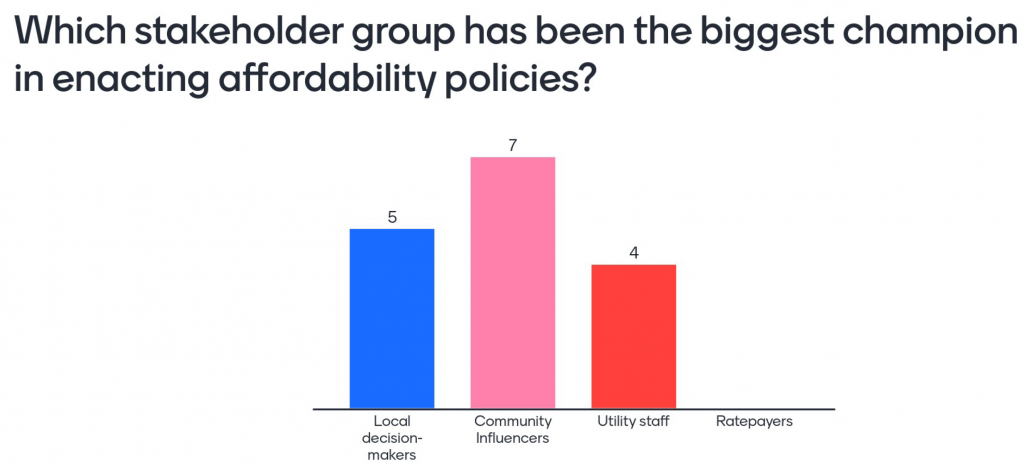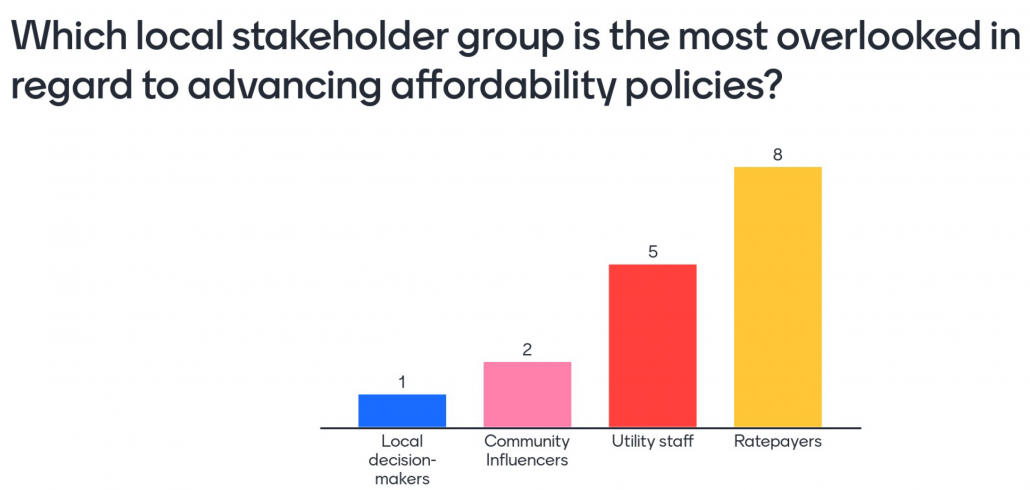Gaining support from key local stakeholders to advance high-impact water affordability policies in the U.S.
June 6, 2024
By: Grace Harrison, Project Manager of Water Equity Research of the UCLA Luskin Center for Innovation (LCI); Gregory Pierce, Director of the Human Right to Water Solutions Lab, LCI; and Christine Curtis, Research Associate of the Pacific Institute
Key Takeaways
- Advance high-impact water affordability policies: Experts in this workshop defined high-impact water affordability policies as having outcome-based accountability, entitlement/enrollment targets, and needs-based benefit allocation approaches.
- Develop Comprehensive Programs: To improve affordability programs’ impact and reach, utilities should share data with other local organizations, social services, utilities, and policymakers, establish program auto-enrollment for qualified customers, and consider renter’s unique needs when designing programs.
- Consider Decision-maker Dynamics: Local policymakers’ support of and decision-making around affordability policies is influenced by external and internal factors, including advocacy efforts, legal constraints, and public perception.
- Utilize Utility Staff’s Dual Role: Utility staff members play a dual role in advocating for and implementing policy changes. Staff can be effective internal advocates for utility affordability policies, and some staff may be able to discuss the benefits of such policies with community members. However, staff should ensure affordability policies and advocacy operate within current legal constraints.
- Engage Community Members: Community members, including but not limited to direct ratepayers, can be overlooked when developing high-impact water affordability policies. Utilities and local decision-makers should work with trusted community partners, such as local nonprofits and community advocates, to inform affordability policies and harness their advocacy power to advance affordability policies.
- Collaborate Effectively: Building trust, identifying shared objectives, and maintaining open lines of communication are critical to building successful partnerships between local decision-makers, utility staff, and community members.
The Project
The Pacific Institute, Corvias Infrastructure Solutions (CIS), the University of California Los Angeles (UCLA) Luskin Center for Innovation, and the University of North Carolina (UNC) Environmental Finance Center are collaborating on The Water Research Foundation (WRF) project 5179, Feasibility and Applicability of Emerging Utility-Led Innovations in Addressing Affordability, which documents emerging innovations and strategies for advancing utility-driven affordability efforts in the United States.
In March 2024, we convened a virtual workshop with 17 water professionals from 15 organizations. We discussed promising strategies to gain legislative, utility, and local community support for high-impact water affordability policies. Participating organizations included eight water utilities, five national (U.S.) nonprofit agencies, and two community-based organizations. In an initial poll, 12 participants indicated that efforts to gain support for high-impact water affordability policies in their community are going well, while three expressed feeling challenged. The workshop included breakout groups to foster conversation and ensure all participants’ experiences were incorporated. Participants shared numerous ideas to build support for high-impact water affordability policies based on lessons learned from their own experiences. The project team analyzed workshop transcripts, providing information on the key themes raised by participants’ overarching perspectives and experiences.
Water and Wastewater Affordability Challenges
Even before the COVID-19 crisis, customer affordability was a growing national challenge in the United States for the water and wastewater sector due to economic pressure on household budgets and steadily rising utility rates. By 2022, an estimated 10 percent of U.S. households faced affordability concerns, spending 4.5 percent or more of their annual household income on water utility bills (Cardoso and Wichman 2022). Despite the well-documented need to support households with more inexpensive water bills, enrollment in customer assistance or affordability plans varies widely and tends to be lower than enrollment in other social safety net programs like Medicaid or SNAP. Many current water affordability policies risk falling short of fully reaching customers or offering support that meets household budgeting needs.
Relatively little research has examined the political dynamics and communication strategies that motivate key stakeholders, including local decision-makers, utility staff, and ratepayers, to address affordability at a substantial scale. This research project aims to study how these key stakeholders can be and are influenced, and how they influence each other, to effect high-impact changes in affordability policies. Though “high-impact” is inherently subjective, we defined it for participants as water affordability policies with outcome-based accountability, entitlement/enrollment targets, and needs-based benefit approaches.
This blog discusses key insights from the March 2024 workshop. The workshop was the second in a series of four with accompanying blogs. The findings discussed here and in other workshops will be further analyzed and included in a final report published by the Water Research Foundation, anticipated in Spring 2025.
What are key considerations for implementing high-impact water affordability policies?
Streamlining to increase enrollment: Enrollment in a robust customer assistance program (CAP) is usually one of the primary metrics used to evaluate its impact. One participant noted the limiting factor of their utility’s high qualification threshold, whereas another discussed the success of including renters in their affordability programs by providing water credits on their electric bills. Several other participants discussed how data-sharing across income-based social service programs can streamline the application process so customers only have to fill out one application to enroll in multiple programs. Expanding enrollment criteria can also increase program participation.
Balancing customer care with revenue needs: Some participants discussed the tradeoffs of prohibiting water shut-offs due to non-payment, a common policy at the height of the COVID-19 pandemic. Recent water-shutoff moratoriums and post-moratoria policies have caused utilities to incur more uncollectible accounts than in the past which must be recovered from revenue-producing water sales, thus potentially adding pressure to rates and affordability.
Understanding and overcoming legal restrictions: States have different regulations regarding how local water systems’ rates can be set, and participants expressed varying opinions about working within or around existing regulations. In some states, utilities cannot offer customer-differentiated rates unless they justify that difference through a cost-of-service study and ensure adherence to restrictive state law. Whereas in other states, flexibility in state law means utilities can more easily make customer-differentiated water rate adjustments. One non-utility representative even discussed their positive experience working with utilities in legally constrained environments to demonstrate the ability to still provide customers who cannot afford their water bill with support in ways that are also legally defensible.
Who influences high-impact water affordability policies and what do they need to do to ensure effectiveness?
Local decision-makers: Encompassing utility board members, elected officials, and government appointees, local decision-makers play a crucial role in the implementation and success of high-impact water affordability policies. Their involvement is characterized by a balance of seeking beneficial outcomes for communities and navigating political and operational challenges. Water affordability policies typically require approval from water utility boards or city councils, roles that can change hands fairly frequently, impacting affordability programs’ implementation and longevity. Several participants discussed difficulties communicating their utility’s funding needs to support water affordability with decision-makers, and other participants noted that decision-makers are influenced by various factors, including advocacy at the state and federal levels.
Utility staff: Several participants framed utility staff support for affordability policies as especially valuable as the ultimate mandate of utilities is to serve their communities. Regardless of shifting political climates, utility staff, from managers to customer service employees, can serve as steady champions of high-impact water affordability policies. Additionally, although utility staff can face internal opposition to affordability policies, they may have better leverage than those outside the utility to overcome it. One participant noted that utility staff can also influence the public’s perceptions of water affordability policies by discussing policies’ value to the community and publicizing the utility’s water services more broadly. On the other hand, participants discussed how some utility staff might feel isolated in their affordability advancement efforts by local decision-makers advocating for measures that run counter to utilities’ affordability goals. An example of this is localities decreasing housing development fees, which can in turn force utilities to increase their rates on existing customers.

A poll result from the workshop.
Community members: One participant commented that the term “ratepayers” (used in our original polling, as shown in figures in this blog) is not inclusive of utility customers who do not pay a water bill, such as renters, but are still impacted by water affordability challenges as water bill increases can lead to rent increases. Other terms such as “neighbors,” “customers” or simply “community members” may more accurately represent the fact that all utility customers are members of the broader community and can benefit from affordability policies. A couple of participants questioned the value of engaging extensively with community members to influence affordability program designs, as they may not have the time or expertise to weigh in on some details; however, most participants identified them as a valuable stakeholder group to advance affordability policies.
Eight participants selected community members as the stakeholder group most overlooked in terms of potentially playing a larger role in supporting and advancing affordability policies. One participant discussed the opportunities generated by creating sustainable pathways for community members to share information with their neighbors. These pathways could be more formalized community outreach jobs, or informal pathways, such as community events.
Respected community leaders, whether associated with local nonprofits or individual advocates, can serve as valuable sources of information for utilities, and vice versa; utilities can share important affordability information with neighbors through these trusted messengers.

A poll result from the workshop.
What are examples of collaboration between stakeholder groups? Why were collaborations successful or unsuccessful?
Participants agreed that successful collaborations to achieve water affordability involve a multifaceted approach where trust, cross-sector partnerships, effective communication, transparency, and shared goals play pivotal roles. Building trust between parties can involve informal interactions, shared experiences, or more formal collaboration pathways. One participant discussed the benefit they have seen from a community advisory committee organized by a local nonprofit representing community groups, utility staff, and regulators to discuss the utility’s affordability program. This provides an outlet to propose recommendations and ideas, and they reported the utility has considered and implemented recommendations made in this setting. Other participants discussed collaboration between utilities and social services programs to maximize data sharing and minimize work for applicants. A typical collaboration challenge is the lack of transparency, particularly in sharing data and information. Additionally, collaborations can falter when there’s a misalignment of goals or priorities among stakeholders.
Conclusion and Next Steps
This second workshop identified the roles of local stakeholders in advancing high-impact water affordability policies and programs. Participants also discussed various strategies for enacting and maintaining high-impact water affordability policies. These discussions informed the project team’s understanding of the topic. They also highlighted challenges faced by utilities seeking to advance affordability policies and the steps they can take to proactively adopt and maintain high-impact approaches.
The third workshop for this project focused on the role of conservation and efficiency for water affordability, was held in May 2024. Stay tuned for the next blog in this series!
To learn more about LCI’s research on water and wastewater affordability, visit our website.








